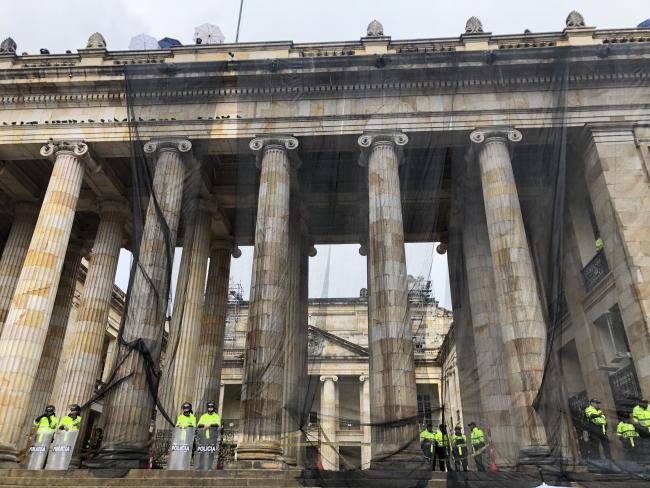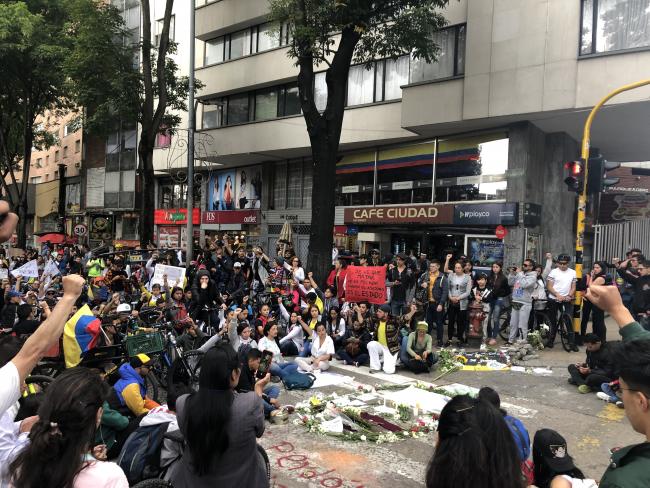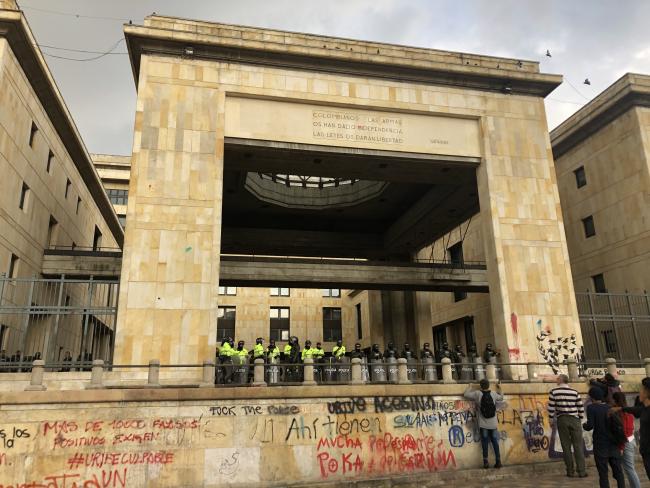
This December, we are asking readers to make a tax-deductible contribution before the year is over to ensure NACLA continues to provide only the best in progressive news and analysis on Latin America. Visit nacla.org/donate
When police shot tear gas into Bogotá’s Plaza de Bolívar on a recent Thursday afternoon, it sent the previously calm crowd into chaos. The plaza is large and wide, with broad stone civic buildings on each side and a number of narrow streets feeding into the square. As the tear gas canisters hit the ground and sent plumes of white smoke into the air, people ran, their eyes and noses burning. While the crowd had been peacefully protesting for most of the afternoon, the tear gas dispersed the demonstration into different directions. The pretext to fire came when some protesters—“vandals” or undercover police “infiltrators,” depending on who you ask—began to throw rocks and tear down and burn large swaths of thick netting strung up to protect the buildings from graffiti and other harm.
The scene showed how Colombian security forces consider infrastructure a pillar of order in the nation’s capital city. The plaza, designed during Spanish colonial times in the damero or “checkerboard” style of urban planning, was meant to maintain imperial order through both spatial and social means. In addition to this historical symbolism, today it is difficult to enter or exit the plaza en masse because of the way the long, narrow feeder streets split a crowd. Nevertheless, the plaza has a storied history as a site of dissent, from calls for independence in the colonial period to 20th century protests, as well as violent acts during the country’s prolonged conflict.
In the recent protest, the civic buildings themselves—a historic cathedral, the seat of the mayor of Bogotá, the Palace of Justice, and the National Capitol—were a principal reason that the national strike turned from peaceful to violent. This shows just how much property destruction is a trigger for police brutality both rhetorically and in real-time reactions in the street. In the urban space of the city, it seems that protection of infrastructure often takes precedence over human rights. Yet protesters, too, have critiques about the politics of infrastructure.
The recent protests have signaled a new dimension in Colombian popular politics. Organizers originally planned the Thursday, November 21 national strike to protest cuts to the pension system and labor reforms, and an array of unions joined the cause. Other groups soon attached a number of additional issues that have sparked popular discontent with the administration of right-wing president Iván Duque. These include the rampant and ongoing assassinations of Indigenous and other social leaders and human rights defenders, hundreds of whom have been killed since 2016, as well as inadequate implementation of the 2016 peace deal between the Colombian government and the FARC. The peace accords ended over 50 years of armed conflict that left an estimated 260,000 people dead and 80,000 disappeared.
Adding fuel to the protests, a scandal broke two weeks ahead of the strike revealing that the military had killed at least eight minors in an aerial raid. The army had already been implicated in the brutal killings of demobilized ex-FARC combatants, such as Dimar Torres, who died in April. “For deaths in the countryside, we march in the cities,” read a large pink banner hanging from a window in downtown Bogotá last week. University student leaders, who have also suffered repression—authorities raided 27 homes days before the strike—rallied for increased education funding and against the brutality of Colombia’s riot police unit, ESMAD (Escuadrón Móvil Antidisturbios).
As popular protest movements explode across the region and world, many in Colombia, like in Chile, see the broad set of issues as interconnected. They argue that the Duque administration, in office for a little over a year, must do more to protect the peace process, ensure human rights, fund robust social programs, and protect the environment.
Over 200,000 people marched on the first day of the protest, according to official estimates, and the day marked a shift from more siloed protests to broad-based popular coalitions coming together. This dynamic has gathered demonstrators en masse day after day for nearly two weeks. On the first day, large marches occurred in Bogotá, Medellín, Cali, and other cities, with smaller ones scattered across the country. The national strike ended with a spontaneous cacerolazo that lasted for hours as people banged pots and pans in the street and out their windows, which many saw as a rejection of violence.
As protests continued on Friday, November 22, police deployed tear gas throughout the capital city, leaving a heavy cloud hanging over buildings and acrid air. Bogotá’s mayor, with the support of the Colombian president, implemented the first curfew in 42 years. The government had issued a curfew in Cali the night before, and in both cities mass panic ensued as rumors flew that robbers were taking advantage of the empty streets and busy police to invade homes. Though officials blamed social media, some interpreted the events as a government plan to sow fear. A curfew was also issued on Friday in Santander de Quilichao, in the Cauca department, where a car bomb exploded in front of a police station, causing multiple deaths and injuries.
Tensions stewing since before the strike with soldiers in the streets and police raids on activists’ homes continued to mount in Bogotá on Saturday, November 23. Riot police shot 18-year-old student Dilan Cruz in the head with a projectile as he ran from them. He remained in critical condition while protesters placed flowers around his blood on Calle 19 in downtown Bogotá. Their solemn songs, chants, and moments of silence gave way to a more resilient form of protest. Cruz died on the following Monday evening; the medical examiner’s office ruled his death a homicide. Debates raged in the week since his death about his conduct in protests, with one senator declaring Cruz a “vandal,” as if that would justify his murder. Meanwhile, Amnesty International has denounced the detention of over 100 protesters and verified a number of other videos of human rights abuses, including an ESMAD officer in full riot-control gear kicking a young protester in the face.

After Dilan Cruz became another banner spurring the protests, the marches grew less tense as police began to stand down. Demonstrators brought cacerolas, drums, and signs, contributing to an almost-festive atmosphere punctuated with moments of grief. In a post-peace deal Colombia, the large-scale, ongoing protests indicate that there is now space and—possibly—popular will for a progressive movement with broad social goals whose dissent is no longer reduced to simplistic identification with guerrilla conflict.
“Vandalism” and Repression
Bogotá’s infrastructure does not serve all people equally, and it has thus become a target for some urban protesters. The TransMilenio bus stations draw particular ire. The administration of Bogotá’s outgoing mayor Enrique Peñalosa (1998–2001, 2016–2019) presents the system as a success, emphasizing its sleek buses with devoted lanes. But this papers over the fact that local government has not addressed overcrowding, high fares, or the large areas of the city underserved by public transit. The system was built with public funds and functions with government oversight, yet it awards operating contracts to private companies; corporations reap the profits of public investment. On November 21, one TransMilenio station near the Universidad Nacional was largely dismantled, and 68 other bus stations have been damaged.
Likewise, many banks ended the first weekend of protest with broken windows and graffiti. “Vandals are those who steal from their own people,” one graffiti in Bogotá’s city center read. Broken glass, political graffiti, and sidewalk stones chipped to use for throwing colored the city’s public space. Government buildings were another obvious target—red and black writing denouncing the state as terrorists and killers was splashed across the Palace of Justice by Sunday afternoon. Graffiti and chants often cite former right-wing president and Duque patron, Álvaro Uribe. During Uribe’s 2002-2010 term, Colombian army brigades routinely executed civilians under a system that politically and financially incentivized killings of anyone they could pretend was a guerrilla fighter, leading to thousands of “false positives.” “Who gave the order? 5,763 falsos positivos.” read graffiti on a historic statue of Simón Bolívar eerily wrapped in green plastic as the national strike began on November 21. The plastic would be torn down as the tone of the protests turned and the police covered the plaza in tear gas.
The graffiti referenced a mural painted in October by the Puro Veneno collective that the Colombian army infamously covered up in a recent artistic rendition of the battle over the right to public space. Under the question “Who gave the order?” the mural near the military academy in Bogotá broke down the statistic of 5,763 victims into numbers listed alongside the names and faces of specific military commanders. After soldiers covered the mural, the artists shared their design online, calling on followers to replicate it all over the city as part of a project called #CampañaPorLaVerdad. In posters and graffiti, it has proliferated in defiance of the silence the army promotes.
The story echoes another recent censorship of a mural by famed artists Powerpaola and Lucas Ospina on a wall of the Centro Colombo Americano. The design, which was covered up, contained an image of Uribe as both a marionette to a Trump-like shadow figure and Duque’s puppeteer, among other figures. In early November, a collective including the Madres Falsos Positivos de Soacha y Bogotá reimagined the wall as a #CampañaPorLaVerdad mural, and graffiti of Dilan Cruz’s name has recently appeared. “The truth is not erased with repression,” the new mural says.
But the government maintains that public order hinges on the maintenance of property, and vandalism, as President Duque said in a speech on the evening of November 21, is “not an expression of popular will, nor is it legitimized by the right to protest.” However, it’s worth questioning who this narrative of “vandalism” serves. Sympathetic observers might see infrastructure destruction embodying political statements, but many in Colombia oppose it across the political spectrum. For peaceful protestors, it detracts from the message of the strike and serves as the pretext for police repression. Students were filmed in the main plaza on November 22 scrubbing graffiti off government buildings. Other videos have surfaced of protestors trying to stop vandals, including on November 21 in the Plaza de Bolívar. “¡Sin violencia!” many chanted last week. Whether the “vandals” are protesters or undercover police “infiltrados”—or, perhaps, a mixture of both, given that police admitted to taking part in recent vandalism—those who oppose the protests from within and outside the Colombian government use the language of “vandalism” to justify repression.

While the link between infrastructure and public order has a broad global history, in Bogotá it bears the particular baggage of the historic April 9, 1948 riots. That day, after prominent politician Jorge Eliécer Gaitán was shot on a busy downtime street at lunchtime, popular furor exploded into the bogotazo. People who believed that the ruling Conservative government had ordered the assassination swarmed into downtown Bogotá, where they smashed, burned, and looted over 150 buildings, including civic structures, Conservative party newspapers, police stations, businesses, churches, and the homes of politicians. Present-day ire directed at public transit echoes the protesters in 1948 who also burned and overturned streetcars. Historian Herbert Braun has written that the riots were an attack on the very social order, and the crowd remains largely anonymous. Casualties were likely in the thousands.
In the wake of the 9 de abril, as unrest spread across the country, authorities tied civilizing rhetoric to the notion of what constitutes legitimate forms of protest and politics. Gaitán’s populist followers had sought to disrupt easy establishment politics through formal means and, when he was killed, through deeply agitated destruction. An extended and bloody period known as La Violencia followed; the disturbances exacerbated partisan in-fighting, which, coupled with government repression, resulted in an estimated 200,000 deaths in the 10 years after 1948. The violence of the riots and their role in propelling instability are not defensible, but they do beg the question of what kinds of political inclusion a less denigrating discourse around protest might have allowed, both in and since 1948. On Saturday, November 23, in the intersection beside where Gaitán was gunned down, police tear gassed protesters singing the national anthem with their hands up in a particularly potent symbolic scene.
Public Space for the People
Given the forum, dissenters in the Colombian populace have argued more explicitly for infrastructure that serves their needs as an imperative of the state. One salient example is the peace accords with the FARC. The 2016 agreement contains extensive provisions for rural infrastructure as a form of participatory development, including requests for roads, irrigation, and electricity, as well as programs for health care, education, housing, and poverty eradication. These pillars center community needs and participation, especially through gender equity. One would think that enacting this mandate to build new programs would be attractive to the Colombian state as an opportunity to concretely extend state power into formerly contested territory. Yet, although the peace accord explicitly acknowledges the need to “strengthen the institutional presence of the State in the territories affected by illicit crops,” the government has been slow to act.
While some infrastructure projects are in the works, as of July 2019, only a small percentage of the infrastructure-related aspects of the accords had been completed. Duque’s criticism of the peace deal and his policies of inaction show that his administration’s political interests—especially appealing to right-wing opponents of the FARC agreement—take precedence over popular participation in building infrastructure that could mutually benefit rural residents and the broader interests of the Colombian state. Observers call for promoting the “accord programs as national public goods” and sustaining the implementation process “by insulating it from the divisiveness of everyday politics.” Protesters note the disparities not just in rural areas, but also in Bogotá. “When will the government comply with the peace accords?” graffiti in the city center read as protests entered their second week.
It remains to be seen how seriously the Duque administration will heed protesters’ calls for change. The president has established a national dialogue and met with some leaders, but many of his comments thus far have denigrated and misunderstood the new popular movement, and he has not met their demands. Bogotá’s mayor-elect Claudia López has called for greater humility from his administration and dignified the seriousness of broad calls for change, as have a number of senators.
In many ways, the “vandalism” discourse recycles an old refrain in which Colombian elites have maintained power through delegitimizing dissent. By ignoring the legitimate political arguments contained in street protest, government officials attempt to rob popular politics of its power. But on the night that Dilan Cruz was fatally wounded, people showed that they would keep resisting. Despite the casualties across the country and the cloud of tear gas that hung over Bogotá for days, marchers turned out all over the city, including some who laid down in the busy road where the ESMAD felled Cruz. With flickering candles, they occupied the street to grieve and to reject the use of public space as an instrument of repression, demanding instead an infrastructure that serves the people across the country.
Amanda C. Waterhouse is a PhD candidate at Indiana University studying the history of cold war Latin America and United States foreign relations. Her dissertation examines the dynamic between Colombian infrastructure and protest from the late 1940s to the early 1970s, especially related to U.S.-funded urban planning, public works, and universities.
The author extends special thanks to Margarita Martínez Osorio, Santiago Suárez Gómez, and Fabián Plazas Diaz for sharing information and resources for this article.

